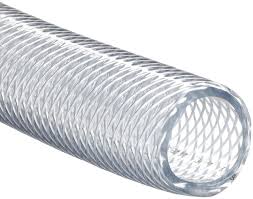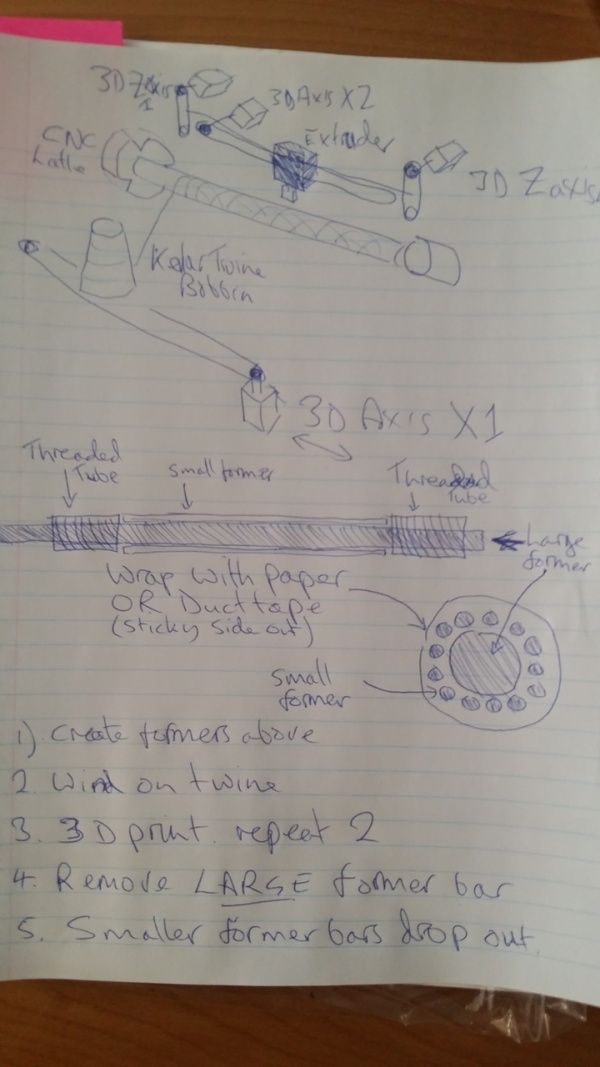Fibre Reinforced Pipe 3D Printer
Basics
- A Device that Produces Fiber Composite Reinforced Pipes and/or Fiber Composite Reinforced Pipes
- Allows for production of high strength componets for framing of devices such as vehicles like cars, bikes, and velomobiles
- The Rationale is that space frames and geodesic shapes (including buildings and tents) with light weight pipes can easily be constructed with very efficient use of materials, not requiring solid infill yet still retaining high rigidity and structural strength.
http://img.youtube.com/vi/xuXB4aWmcDk/0.jpg
Basic Process
Basic concept is to wrap continuous strand fibre several times round a "former" (metal bar) in a cross-hatch arrangement then 3D print a single layer of plastic over the top, then repeat that process for several more layers. With diagonal cross-hatching the strength and rigidity will be enormous.
Fiber Composite Reinforced Pipes
- The CNC lathe part rotates a metal "former" around which you wrap paper (or duct tape) by hand, to start off (This acts as a sort of "Release Agent"
- A Coating on the rod like PEI, and/or a release agent may be an alternative, although (bed?) adhesion is an issue
- A Base Layer of the core filament is layed down by a FDM Nozzle And Extruder on a 1 axis Universal Axis (Perhaps 1-3 "layers")
- A Bobbin with the core fiber (Anything from natural fiber (Hemp, Cotton, Wood) to Semi Sythetics (Rayon), to Synthetics (Fiberglass, Carbon Fiber, Kevlar) is moved along via the same Universal Axis as CNC lathe part turns the former.
- Upon reaching the other end, the bobbin direction reverses in order to create cross hatching. This is repeated a few times depending on the required strengths etc (2-4?)
- The bobbin winding stops and the 3D printer takes over, laying down a another layer of 3D printed material covering the twine
- Another crosshatch of twine is added using the CNC lathe
- The Process is then looped untill the required specifications are met
- Note that the bobbin-nozzle assembly must move backwards from the former-pipe lathe assembly due to the diameter gradually growing. This is achived using 2-3 Universal Axis underneath the one holding the assembly
Fiber Composite Reinforced Bars
- Same as the pipes, but the former is not covered in a release mechanism/agent and thus becomes part of the end product
- Thin Metal Bars Could Be Used
- Plastic Rods are Also an option
- Essentially Multiplies their strengths thus making more efficient use of materials (Less Metal Can Be Used Etc) or Stronger Parts (Reinforced Bars are Stronger that Standard Bars, especially in Torsional Strength, Tensile Strength and perhaps Shear Strength
Code WorkFlow
- A (Custom?) Program Is Used
- This takes the inputs of former diameter, former length, desired outer diameter, and layer/run diameter (or number of "passes/runs" ie one or three for basecoat, two runs of fiber crossing, or four, etc)
- It then Uses This to Generate GCode
- This is sent to the device, or an attached Octoprint Module
Properties of Fiber Composite Reinforced Pipes or Fiber Composite Reinforced Pipes
- This Process Produces extremely strong and lightweight pipe is constructed quickly, that should have similar mechanical properties to carbon fibre tubes.
- The Torsional Strength along its length, due to the crosshatching, should also be extremely high.
- The Tensile Strength Should Be High
- The Compressive Strength Should be Reasonable
- The Shear Strength Should be Quite High As Well
- For eco conscious projects, Natural Fibers and Semi-Synthetic Fibers can be used.
- For increased strength, fibre reinforced 3D filament can be considered.
for increased speed, 1.2mm or greater volcano E3Dv6 nozzles cwn be considered, although only for large ID tubes due to the need to have multiple interwoven layers.
TODO details, such as considering epoxy resin at the start and end of pipes
TODO, embedding metal screw threaded fittings into the ends of the pipe as it is formed, to aid in rapid assembly and construction of frames.
Julia Car
- See Also Julia Car
- fibre reinforced pipes, kevlar strands crosshatched sandwiched between layers of CNClathe rotated 3Dprinting
- M10 threaded pipe left at one end right at the other is embedded INTO the plastic and of course wrapped with lots of kevlar strand.
- Divergent3D "nodes" 3D printed fibre reinforced plastic, into which pipes are simply screwed.
- Calfee Design technique (bamboo bike with epoxy soakee cloth wrapping nodes) can be considered
- GABoats geodesic canoe using wood slats, more kevlar twine and heatshrink dacron for the outer skin
- and electric and downhill mountainbike parts are then used because the above only weighs 30 to 35kg even at a 5ft x 10ft x 4ft vehicle size.
- actual aluminium or metal parts is drastically reduced, to fastenings, bolts, and intricate pieces etc. -UELVEs_MBC
Pipe vs Rod Debate
- Rods are stronger yet more expensive
- Pipes are cheaper and have a better Strength to Weight Ratio
- From the concept diagram and video above it should be clear that as long as the metal parts are hollow and may fit over the steel "former" bar down the centre of the pipe as it is 3D printed, then not only can the 3D filament (and the twine) be wrapped around the metal part, encasing it in both twine and 3D-printed plastic and ensuring that it is an integral part of the pipe, then because the metal part is hollow, the steel former rod (and the smaller former rods inside) can be pulled or will drop out under gravity from the centre of the finished pipe.
If this is *not* intended to be done (taking the former rod(s) out), for mechanical reasons, or if the end parts cannot be made hollow for some reason, then one alternative is to use a cardboard or other suitable former (perhaps a pre-existing plastic hollow pipe, or thin-walled metal tube) into which the steel end-parts are embedded or attached, prior to the twine-wrapping and CNC-lathe-style 3D-printing process.
With there being no way to remove the internal former if that is the case, the selection of a cardboard or plastic tube is to greatly reduce the weight of the final result. If metal rods are to be left inside the tube, then bearing in mind that they are not really intended to be attached *to* the pipe as it is being 3D-printed, they do not contribute much to the structural strength, and, worse, simply increase the final weight.
Embedding Threads / metal swivels
- There is clearly a need to have strong (stainless steel, high-carbon, cast, or even high strength fibre reinforced plastic such as NylonX) parts at the end(s) of the pipes. These may either be jointed-parts, steel "lock" parts, threaded parts etc. all of which have the fundamental requirement to attach the 3D printed pipe to something, usually termed a "node".
- This could be done via a drill press drilling holes to mount the part, or by using the lathe, or a seperate one to thread the ends
Design and practical construction issues
One of the key reasons for using a metal former (particularly a solid bar) is because of concerns about the pipe "sagging" under its own weight as the 3D pipe is being printed. If cardboard, thin steel tube or a pre-existing plastic pipe is utilised as the "internal former", the concern is that this may not be rigid enough, particularly when considering 3D printing pipes over a metre in length and of narrow OD (15mm or less).
One idea considered was to have a pair of "roller tracker balls" as part of the frame, just underneath where the 3D printer head operates, on which the 3D-printed pipe would sit. The reason for having track-ball-style rollers is because the pipe not only needs to move back and forth in the X-axis, it needs to be *rotated* about the X-axis using the CNC-lathe Stepper Motor, as well, thus requiring *two* degrees of freedom of motion in addition to providing support for the 3D-printed part.
However, here, we see an inherent problem: as the pipe is being 3D-printed, it will *increase in outer diameter*. This would have to be taken into consideration, i.e. the gcode-generator, would have to be fully-aware of the geometry of the machine *and* the construction. As an alternative - for a first iteration - it would be far simpler to not have to do this, and to stick to high-rigidity low-density internal former material (perhaps even titanium or solid carbon fibre).
Filament Options
Lower Cost
- PLA Composites
- ABS Composites
Mid Cost
High Cost/Obscenely High Cost
Optional Coating Plastics (For Surface Finish, Enviromental Resistance etc
- PSU Filament For Enviromental Resistance
- PPS Filament For Enviromental Resistance
- PLA Filament For Vapor Smoothing
Fiber Options
Fiberglass
Continous Carbon Fiber
Kevlar
Material "Recipies"
Semi Reasonable Cost High Preformance Pipe/Rod
- Stainless Steel or Titanium Rod/Pipe
- Carbon Fiber Reinforced Nylon or Polycarbonate core filament
- Fiberglass or Kevlar Fiber
- Optional PSU Coating for enviromental resistance (1-3 Coats/Wraps)
- Sand/Buff for surfaace finish
Obscenely Strong Pipe if Cost is a non issue Idea from User:Eric
- Carbon Fiber PEKK Tensile Strength ~324 MPa Compressive strength?
- Kevlar Fibers (From Wikipedia Fiber Has A Tensile Strength of ~3,620 MPa
- [https://www.3dxtech.com/thermax-pps-3d-printing-filament/ PPS Outer Coating for Resistnace to Abrasion, Chemicals (Solvents), Mildew, and Sunlight
Comments
- If kevlar is cost prohibitive, spring steel wire appears to be cheap and still 1/3 the tensile strength (150 ksi) (lkcl: or hemp twine. it's ecologically sound and highly effective. multiple strands will need to be wrapped around for cross-hatching, anyway).
- Divergent3D nodes - need thread swivels on one end. Is there a plan for this? (yes, a threaded pipe - one left-hand, one right-hand, can be put over the steel former and then integrated into the 3D print. special section on this TBD).

